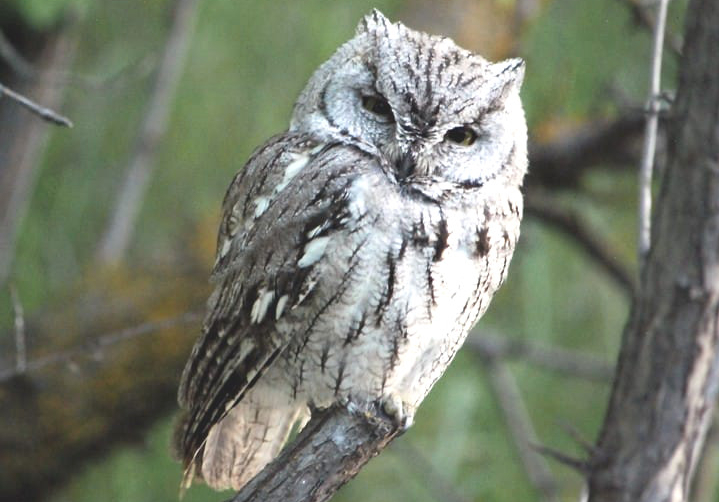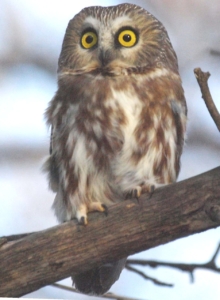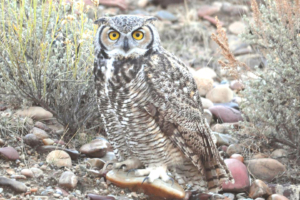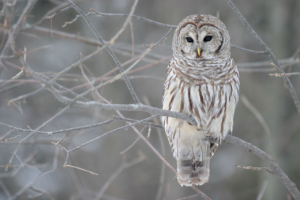SCORES & OUTDOORS: The three most common owls in Maine are quite different
 by Roland D. Hallee
by Roland D. Hallee
During the still of the night at camp, we can hear the sounds of barred owls communicating with each other.
One night last week, we could hear three calling out for each other from different locations. It’s not quite as soothing as listening to the loons, but it does put me back to sleep.
However, one evening, one of our neighbors said they heard a screech owl one evening. That got me to thinking. I didn’t think there were any in Maine.
Generally, it is known there aren’t that many different species of owls in Maine. Mainly, we have the Great Horned Owl, Northern Saw-Whet Owl and the very common Barred Owl. The Barred Owl and the Great Horned Owl live in a wide variety of forested habitats and occupy dense forests, open woodlands, clear-cuts, and even urban environments such as golf courses, cemeteries, and parks with adjacent woodlots.
But first, let’s look at the screech owl.
The northern screech-owls are found in eastern states, such as New Jersey and New York. The screech owls are named for their piercing calls. The normal territorial call is not a hoot as with some owls, but a trill consisting of more than four individual calls per second given in rapid succession (although the sound does not resemble screeching or screaming). They also have a kind of “song” which is used in courtship and, as a duet, between members of a pair. Calls differ widely between species in type and pitch, and in the field are often the first indication of these birds’ presence, as well as the most reliable means to distinguish between species. The distinctness of many species of screech owls was first realized when vastly differing calls of externally similar birds from adjacent regions were noted.
According to a state website, if there are any screech owls in Maine, they would be found in the extreme southern part of the state. Actually, eleven species of owls live in or visit Maine for all or a portion of the year. The great horned owl and the barred owl are the most widely distributed owls in the state.
Most owls are nocturnal predators, with hooked bills and needle-sharp talons. They have wide wings, light bodies, and feathers specially designed to allow them to silently swoop down on prey. Depending on the species, owl calls are characterized as being either a hoot, a screech, or a whistle.
The northern saw-whet owl, Aegolius acadicus, is a small owl native to North America. Saw-whet owls are one of the smallest owl species in North America. They can be found in dense thickets or conifers, often at eye level, although they can also be found some 20 feet up. Saw-whets are often in danger of being preyed upon by larger owls and raptors. Northern saw-whet owls are also migratory birds without any strict pattern.
Their habitat is coniferous forests, sometimes mixed or deciduous woods, across North America. Most birds nest in coniferous type forests of the North but winter in mixed or deciduous woods. They also love riparian areas because of the abundance of prey there. They live in tree cavities and old nests made by other small raptors. Some are permanent residents, while others may migrate south in winter or move down from higher elevations. Their range covers most of North America including southeastern and southcentral Alaska, southern Canada, most of the United States and the central mountains in Mexico.
They can weigh from 1.9 to 5.3 ounces, making them one of the smallest owls in North America. They are similar in size to the American robin.
The northern saw-whet owl makes a repeated tooting whistle sound. Some say they sound like a saw being sharpened on a whetstone. They usually make these sounds to find a mate, so they can be heard more often April through June when they are looking for mates. Despite being more common in spring, they do vocalize year round.
The great horned owl, Bubo virginianus, also known as the tiger owl (originally derived from early naturalists’ description as the “winged tiger” or “tiger of the air”) or the hoot owl, is a large owl native to the Americas. It is an extremely adaptable bird with a vast range and is the most widely distributed true owl in the Americas. Its primary diet is rabbits and hares, rats and mice, and voles, although it freely hunts any animal it can overtake, including rodents and other small mammals, larger mid-sized mammals, birds, reptiles, amphibians, and invertebrates.
The great horned owl is generally colored for camouflage. The underparts of the species are usually light with some brown horizontal barring; the upper parts and upper wings are generally a mottled brown usually bearing heavy, complex, darker markings. All subspecies are darkly barred to some extent along the sides, as well.
The great horned owl is the second-heaviest owl in North America, after the closely related, but very different-looking snowy owl. Although the snowy owl is not common in Maine, I have seen one on two different occasions. Once on the fence post of a pasture, and the other standing in the breakdown lane on the interstate highway.
The great horned owl is heavily built, with a barrel-shaped body, a large head, and broad wings. Its size can vary considerably across its range, with populations in interior Alaska and Ontario being largest and populations in California and Texas being smallest, though those from the Yucatán Peninsula and Baja California appear to be even smaller. Adult great horned owls range in length from 17 to 25 inches, and possess a wingspan of three to five feet). Females are somewhat larger than males.[
They are distributed throughout most of North America. I once saw a great horned owl in flight ahead of us while riding a snowmobile trail in Palermo. It was after dark and I can say they are a magnificent bird.
Typically, great horned owls are highly sedentary, often capable of utilizing a single territory throughout their mature lives. Although some species such as snowy owls, northern saw-whet owls, long-eared and short-eared owls are true migrants, most North American owls are not migratory and will generally show fidelity to a single territory year around. In great horned owls, mated pairs occupy territories year-round and long-term. Territories are established and maintained through hooting, with highest activity before egg-laying and second peak in autumn when juveniles disperse Most territorial defense is performed by males, but females frequently assist their partners in hooting contests with neighbors or intruders.
The barred owl, Strix varia, also known as the northern barred owl or, more informally, hoot owl, is a large species of owl.
Barred owls are brown to gray overall, with dark striping on the underside contrasted immediately above that with similarly-dark and tight vertical barring about their throat and nape. Barred owls are largely native to eastern North America, but have expanded their range to the west coast of North America where they are considered invasive. Mature forests are their preferred habitat, but they can also acclimate to various gradients of open woodlands. Their diet consists mainly of small mammals, but this species is an opportunistic predator and is known to prey upon other small vertebrates such as birds, reptiles, and amphibians, as well as a variety of invertebrates.
The barred owl is distributed throughout most of the eastern United States, as well as much of southern Canada. They are found as far northeast as much of Nova Scotia (western two-thirds), New Brunswick and in much of Québec, up to Lake Mistassini, and Ontario, up to Moosonee.
The barred owl ranges in every part of the eastern United States continuously from northernmost Maine down throughout New England, the Mid-Atlantic states, much of the Midwest, the Southeast United States and all of Florida. A wandering barred owl was once seen flying over Lake Michigan 30 miles from the nearest land.
The barred owl, like most owls, is largely adapted to nocturnality. Between 5 a.m. and 8 p.m., juvenile barred owls were recorded to sleep an average of 28 percent of each hour. Peak times in Minnesota were found to be right after sunset and just before dawn. Nonetheless, they are not as fully nocturnal as many owls and rank around sixth amongst 19 regular North American owl species for the regularity of their activity outside of nightfall, especially in particular circumstances such as when a rival or a human impersonator is emitting barred owls calls or whilst hunting. Often daytime activity tends to be early in the morning or around dusk but potentially at any time (overcast days being preferred).
Owls are interesting creatures. An old myth exists that owls are intelligent because they look intelligent. Well, here is the truth: The wise owl appears in everything from The Iliad to Winnie the Pooh. But, it turns out, though they’re excellent hunters, owls probably aren’t any smarter than a lot of other birds. In fact, they may be significantly worse at problem solving than other big-brained birds like crows and parrots.
Roland’s trivia question of the week:
Name the only two players to win a World Series with both the Boston Red Sox and the New York Yankees.







 by Larry Sikora
by Larry Sikora

 (NAPSI)—Nasal congestion is nothing to sneeze at. It affects roughly 20 percent of the population and is associated with reduced quality of life, difficulty sleeping, reduced daytime performance, and increased need for healthcare. In addition to the physical misery, it is estimated the annual financial impact of chronic congestion is more than $5 to $10 billion. Fortunately, scientists are coming up with new and better ways to deal with the problem.
(NAPSI)—Nasal congestion is nothing to sneeze at. It affects roughly 20 percent of the population and is associated with reduced quality of life, difficulty sleeping, reduced daytime performance, and increased need for healthcare. In addition to the physical misery, it is estimated the annual financial impact of chronic congestion is more than $5 to $10 billion. Fortunately, scientists are coming up with new and better ways to deal with the problem.




